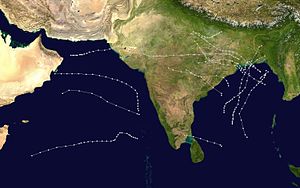| 1970 North Indian Ocean cyclone season | |
|---|---|
 Season summary map | |
| Seasonal boundaries | |
| First system formed | May 2, 1970 |
| Last system dissipated | November 29, 1970 |
| Strongest storm | |
| Name | Thirteen |
| • Maximum winds | 185 km/h (115 mph) |
| • Lowest pressure | 960 hPa (mbar) |
| Seasonal statistics | |
| Depressions | 15 |
| Deep depressions | 11 |
| Cyclonic storms | 7 |
| Severe cyclonic storms | 3 |
| Total fatalities | 500,805+ (Deadliest tropical cyclone season on record) |
| Total damage | $86.4 million (1970 USD) |
| Related articles | |
The 1970 North Indian Ocean cyclone season had no bounds, but tropical cyclones in the North Indian Ocean tend to form between April and December, with peaks in May and November. The 1970 season saw a total of seven cyclonic storms, of which three developed into severe cyclonic storms. The Bay of Bengal was more active than the Arabian Sea during 1970, with all of the three severe cyclonic storms in the season forming there. Unusually, none of the storms in the Arabian Sea made landfall this year. The most significant storm of the season was the Bhola cyclone, which formed in the Bay of Bengal and hit Bangladesh on November 12. The storm killed at least 500,000, making it the deadliest tropical cyclone in recorded history.[1] The season was also the deadliest tropical cyclone season globally, with 500,805 fatalities, mostly due to the aforementioned Bhola cyclone.
- ^ The world's worst natural disasters Calamities of the 20th and 21st centuries CBC News. Retrieved 2010-10-29.